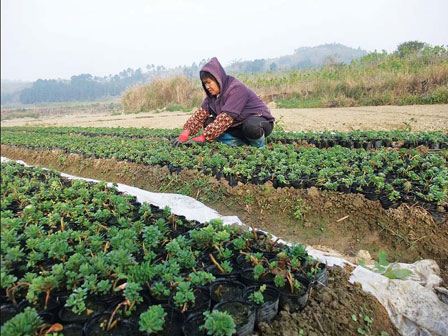2001 flood left legacy of contamination
 |
|
Tong Yue'e, a 58-year-old villager, cultivates herbs in December to be transplanted onto polluted land in Huanjiang county, the Guangxi Zhuang autonomous region. After it is transplanted, the plant will absorb heavy metals that contaminate the soil. Much of the land in the area was contaminated by residue left after a flood in 2001. (Cheng Yingqi / China Daily) |
HECHI, Guangxi - Tan Shi is used to heavy rain, so it never occurred to him during a weeklong storm in 2001 that the inundation would pose lethal dangers for years.
It was not a "dramatic" storm by South China standards, where typhoons are not unusual. All 90 people in Tan's village - Fulong, in Huanjiang county, the Guangxi Zhuang autonomous region - survived.
But the rainstorm flooded three depleted iron mines on an upstream bank of the Dahuan River and inundated 667 hectares of farmland.
After the floodwaters receded in June 2001, Tan said, foul-smelling, various-colored substances coated the corn and sugarcane fields.
"I was only 16 and not at all aware of the damage these substances could do," Tan said.
Crop yields decreased sharply in the village. Worse yet, about 10 people were diagnosed with tumors in the ensuing years, and some of them died.
The killer was those substances, Tan and his fellow villagers learned several years after the storm.
"When I found out, my heart sank, and I thought it was the end of the world," he said.
The mixtures of lead, zinc, sulfur and arsenic "will kill you if you ingest only half a gram of them in a day", said Lei Mei, a professor at the Center for Environmental Remediation of the Institute of Geographic Sciences and Resources Research, under the Chinese Academy of Sciences.
Hope came in 2010, however, when a group of scientists planted Pteris vittata, or Chinese brake fern, in every corner of the village.
The plant absorbs heavy metal contaminants from the soil bit by bit.
Chen Tongbin, director of the environmental remediation center, said the fern has been the focal point of the academy's land-cleaning effort in Hechi since lab experiments proved its cleansing ability in 2005.
Chen's team has planted 60 hectares of polluted land in Hechi with the fern since 2010, and by the end of this year, 85.3 hectares will be covered. After that, the method will be promoted in more places across the country.
"Having a way to remove pollutants from soil is important because more than 90 percent of all kinds of pollutants in the air or water end up in the soil," Chen said.
China has more than 10 million hectares of arable land that is contaminated by heavy metals, according to a survey released by the Ministry of Land and Resources in 2006, the latest data available. By late 2008, the country had 121.73 million hectares of arable land to feed its population of 1.37 billion.
After the fern becomes saturated with heavy metals in polluted soil, the aboveground part of the plant is cut off and burned. A new shoot grows from the root, and the process is repeated.
Chen said the ashes of the destroyed fern top can be refined to recover chemicals.
Lab results show the plant can reduce heavy metals in soil by 10 percent a year, and, theoretically, minimize pollutants to safe levels within three to five years.
The farmers of Tan's Huanjiang county are encouraged by improvements in their land, where the fern grows alongside crops.
The corn Tan harvested last spring was a bit harder and less juicy than corn from other areas. But "it's better than nothing", he said. The heavy metals in the corn do not exceed safe levels.
Tan kept some corn for seed and sold some as animal feed.
"The income was not very handsome, but it gives me hope that my land can be fertile soon," Tan said. "And as soon as my land recovers enough to bring in reasonable earnings, I'll marry."
Scientists worked for years to develop a method of using vegetation to clean polluted soil. Since the 1990s, Chen and his colleagues visited thousands of deserted mines looking for a plant that could recycle the pollutants.
"The most difficult part was to distinguish a plant that 'eats' heavy metals from those plants that are merely immune to them," Chen said.
Scientists tried vast numbers of plants, which were brought to the lab by train.
"While other people lined up to buy train tickets for themselves, I often bought them for me and my plants," Chen said.
Despite the proven benefits, the cleansing method has potential hazards.
"Burning the plants produces smoke. If the method is promoted nationwide, there will be a lot of smoke," said Sun Honglie, a member of the Chinese Academy of Sciences.
"Additional research should be done to ensure a safe means of disposing of the fern," Sun said.
Similar experiments have been conducted since 2007 at a polluted 6.7-hectare site in Gejiu, Yunnan province. The soil there is already clean enough to cultivate sugar cane that meets the national safety standards.
By Cheng Yingqi (China Daily) 15:26, February 02, 2012
Download attachments: